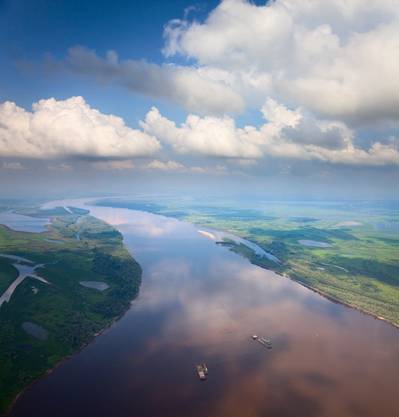A plan unfolds and support grows for a 50-foot Ship Channel to support economical and efficient grain exports. The Big River Coalition remains at the heart of that collaborative effort to make the Mississippi River Mightier.
In 2012, the U.S. Army Corps of Engineers’ (USACE) Institute of Water Resources (IWR) released a report under the direction of Congress to document the status of U.S. Ports to accept post-panamax vessels. The report, entitled, “U.S. Port and Inland Waterways Modernization: Preparing for Post-Panamax Vessels” was officially released on June 20, 2012. Shortly thereafter, the Big River Coalition (BRC) met with representatives of the IWR which published an addendum to the report highlighting the benefits of deepening the Mississippi River Ship Channel to 50 feet. After the addendum was released, the Big River Coalition documented three steps necessary to see the Mississippi River Ship Channel (MRSC) deepened to 50 Feet as:
- COMPLETED: Increase the depth threshold for full Federal channel maintenance from 45 feet to 50 feet. This was done in the legislation known as the Water Resources Reform and Development Act of 2014 (WRRDA 2014).
- Draft COMPLETE: Produce a new General Reevaluation Report and Supplemental Environmental Impact Statement to update the economics detailed in the 1981 USACE Chief of Engineers Report that led to the legislation that authorized the MRSC be deepened to 55 feet in the Water Resources and Development Act of 1986. The development of the Recommended Plan, followed by the Final Report and then culminating in the Director’s Report that is expected to be completed in March 2018, would be the completion of Step number 2.
- LASTLY: Secure approval and funding to allow the USACE (Federal Sponsor) and the non-Federal sponsor, Louisiana Department of Transportation and Development (LDOTD) to execute dredge contracts to deepen the MRSC to 50 feet.
The second step identified the need to produce a General Reevaluation Report and Supplemental Environmental Impact Statement to update the economics detailed in the 1981 Chief of Engineers Report (Chief’s Report). The original Chief’s Report established the economic justification for deepening the MRSC to 55 feet, that was ratified in the Water Resources and Development Act of 1986 (WRDA 1986). The effort to deepen the MRSC was impeded by a channel depth threshold also established in WRDA 1986. Channels deeper than 45 feet required a non-federal sponsor to share the annual maintenance cost with the U.S. Army Corps of Engineers (USACE). The MRSC was deepened from 40 feet to 45 feet because of this restriction. The BRC identified this road block and assisted with changing the legislative threshold to 50 feet. Because of the length of time between the Chief’s Report and the new threshold, the USACE determined that it would have to update the economic justification for the deepening project. Since the new threshold was 50 feet, the LDOTD asked the USACE to revise the economics for a depth of 50 feet.
The new economic justification is now in the Recommended Plan phase and proposes to deepen the MRSC to 50 feet through the Port of Baton Rouge. Based on the optimization, the greatest net benefits are achieved through the deepening the channel to a depth of 50 feet through the Port of Baton Rouge. The deepening from Mile 13.4 AHP to Mile 22 BHP would be to 50 feet Mean Lower Low Water and the deepening on the Crossings up to Mile 232.4 AHP of 50 feet would be based on the Low Water Reference Plane.
The remaining timeline indicates that there are just two outstanding milestones for the MRSC deepening project planning and development phase:
- Final Report (to transmitted from USACE New Orleans to Corps HQ): October 31, 2017
- Director’s Report (Final Determination by Corps HQ): March 30, 2018
The BRC has been assisting the USACE and LDOTD throughout the process and has been promoting the cause in an effort to collect supporters of the project. Recently, the National Association of State Departments of Agriculture (NASDA) and the Southern Association of State Department of Agriculture (SASDA) unanimously supported the Mississippi River Ship Channel deepening to 50 feet project from Baton Rouge to the Gulf of Mexico. The BRC has often discussed the importance of the Mississippi River to the American Farmers, as the Ship Channel connects over 350 million acres of agricultural lands to international markets (global trade).
American farmers export up to seventy percent of U.S. agricultural exports to world markets via waterborne commerce on the Mississippi River and the ship channel deepening project offers significant reductions in shipping costs. The math is easy.
Significantly, the Big River Coalition is pleased to receive the support of NASDA and SASDA and has benefitted from a close working relationship with Dr. Michael G. Strain, NASDA President and Louisiana Commissioner of Agriculture & Forestry, who highlights the importance of international trade to U.S. agricultural producers.
The annual challenge to maintain federally authorized channel dimensions on the MRSC is critical to agricultural exports (and all exports, for that matter) transiting the Mississippi River and Tributaries (MRT). The MRT connects over 350 million acres of agricultural lands to international trade via waterborne commerce on barge and ship traffic departing the revolving door to global trade represented by Southwest Pass (the entrance and exit to the MRSC). Dr. Strain supports the BRC efforts to increase the allocations of the Harbor Maintenance Tax (HMT) to maintain the Ship Channel and to deepen the channel to 50 feet to maximize the reduced transportation costs to the American Farmers.
The Recommended Plan documents a total investment cost of $191,124,016 while increasing the cost of the project significantly. The Benefit Cost Ratio (BCR) of the TSP was 5.47, while the identified BCR in the Recommended Plan has been determined to be 10.75. A BCR of 10.75 does indeed make the Mississippi River Ship Channel Deepening Project a strong competitor for federal funding.
Section 1111 of the Water Infrastructure Improvements for the Nation Act (WIIN) that was signed into Public Law No: 114-322 by President Obama on December 6, 2016, revised established cost-share requirements related to federal navigation projects. The federal cost share is now seventy-five percent and the non-Federal portion is 25 percent. Thus, if the documented total cost is accurate, the Federal responsibility is projected to be $143,343,012 and the non-Federal (LDOTD) would be $47,781,004, although applicability of implementation guidance has not been confirmed.
The Big River Coalition will continue efforts to advise navigation, agricultural and commodity shippers of status of the efforts to deepen the Mississippi River Ship Channel to 50 feet. The Coalition continues working to develop increased support for the deepening project, hopeful that once the Director’s Report is released, the groundwork will have been laid to secure federal funding based on the transportation cost-savings reductions.
The river deepening project proposal was presented with the CG/LA Infrastructure’s 2017 Job Creation of the Year Award. This prestigious award was justified based on the calculation the project would create 16,991 new and permanent jobs determined by an economic justification report entitled, “The Economic Impact of Deepening the Mississippi River to 50 Feet,” co-sponsored by both the BRC and LDOTD. This report by Dr. Tim P. Ryan was officially released on August 22, 2013.
As the Executive Director of the Big River Coalition, I have been tasked with creating a list of supporters to assist with Congressional support once the Director’s Report has been finalized. This effort will continue and become more of a focus once the “Final Report” is delivered from the USACE Mississippi Valley New Orleans to USACE Headquarters.
Editor’s Note
Too often, the deepening of blue water harbors and rivers is considered to be a “ big ship” issue when, in reality, the economies afforded by properly dredged waterways are critical to the inland river export model. With increasing competition from South American countries, some blessed with thousands of miles of naturally deep draft rivers, this aspect of our infrastructure is more important now than it has ever been.
The Author
Sean Duffy is the Executive Director of the Big River Coalition.
(As published in the November 2017 edition of
Marine News)











